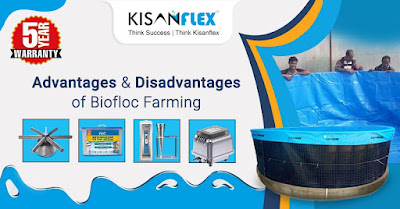BioFloc- An overview
Biofloc technology (BFT) is an innovative and
eco-friendly fish farming technique that involves stock-breeding of fishes, in a
micro-organism rich ecosystem, artificially created in a tank.
The term Biofloc
(Bio=life, Floc= aggregate) refers
to clusters of micro-organisms such
as bacteria, fungi, algae, protozoa, and other kinds of organic particles like
fish faeces and uneaten feed. All these, together, form loose clusters of
organic matter which are held together by a thin film-like substance.
Ecosystems
rich in Biofloc enable recycling of the waste from the fishes into an organic
feed. This not only serves as a protein-rich source of food for the fishes but
also maintains the optimum Carbon: Nitrogen ratio, which is a pre-requisite for viable
production.
The best
part is, the process involves a zero to minimal water exchange within the
ecosystem. This reduces the chances of water contamination and ensures a high
level of bio-security.
BFT was invented by Prof.
Yoram Avnimelech, an Israeli environmentalist in the ’70s to
promote a more sustainable mode of fish farming. In the past few decades,
Biofloc has become increasingly popular all across the world, including India.
But why are
people opting for this method of fish farming, nowadays? What makes it unique
or better than traditional fish farming techniques?
Over the years, Biofloc Technology has been
able to address some major drawbacks of traditional aquaculture practices.
BFT has the following clear advantages over the
age-old traditional methods:
· It is Eco-friendly.
Over-fishing has caused serious damage to the marine and aquatic ecosystems,
resulting in a steep decline in fish catch. Biofloc fish
farming aims to reduce environmental concerns by creating protein-rich
artificial ecosystems in fish tanks.
Further, the Indian tropical climatic
conditions have proven to be congenial for cultivating a wide variety of fishes
and shrimps.
The initial investment in BioFloc fish
farming is considerably low at around Rs. 30,000/- for a 4 meters diameter fish
tank, which generally yields 600 kilograms
of fishes within 5-6 months. The cost of harvesting is an additional
Rs.35000/--40000/- approximately. One can harvest a minimum of 400kgs fish in
such a tank, which converts into a revenue of Rs.56000/-, considering that the
produce sells at Rs.140/kg at the least. The ROI, therefore, is easily achieved
within 2 harvests during a year, not to mention the high-profit margins.
Biofloc fish farming works best with fishes that
can derive nutritional benefits from the direct consumption of the ‘floc’. The
commonly used species for this method are shrimp,
tilapia, koi, carps, etc. All common fish species that can tolerate high
solid concentration in the ecosystem are suitable for Biofloc fish farming.
BFT is a completely scientific approach and therefore,
one must gain a thorough understanding and training on the same, before
venturing into the farming process.
We, at KisanFlex,
strive to create best-in-class products to address the customer requirements
and enhance our services through continuous technological innovations and
end-to-end customer support.
We strongly
believe in the cohesive growth of this nascent industry, by maintaining a close
association across different value chains and creating sustainable value for
all stakeholders.


Comments
Post a Comment